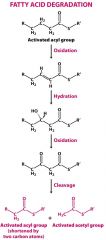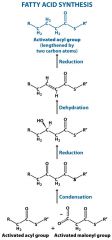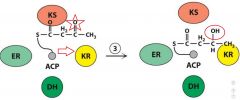![]()
![]()
![]()
Use LEFT and RIGHT arrow keys to navigate between flashcards;
Use UP and DOWN arrow keys to flip the card;
H to show hint;
A reads text to speech;
35 Cards in this Set
- Front
- Back
|
How are Non-Esterified FAs Stored? |
As tri-acylglyerols (TAGs) |
|
|
What role do Non-esterified Fatty acids serve in the body? |
Used as fuel molecules |
|
|
Describe the structure of Non Esterified Fatty Acids |
Long CH chains with a terminal carboxylate group |
|
|
Describe Tri-Acyl Glycerols. |
1. Uncharged esters of FAs + glycerol 2. Fuel storage molecules 3. Stored in adipocytes |
|
|
What features of TAGs make them good energy stores? |
1. Being reduced and anhydrous allows them to be highly concentrated stores of energy chemically - 9Kcal / g of TAG. 2. Being non polar allows TAGs to be stored in the anhydrous form allowing a physically tight packing of TAGs in a given space. |
|
|
How much energy does a gram of TAGs yield when catabolised? |
9 Kcal |
|
|
How much energy does the average 70kg man have stored as TAGs? |
100,000 Kcal! (accounts for only 11kg of the overall weight) |
|
|
1. How are dietary lipids absorbed? 2. What is the basic process of this? |

1. Dietary lipids are digested by pancreatic lipases, they must be degraded before they can be absorbed across the intestinal epithelium. 2. TAGS degraded by lipases to become Fatty acids (FAs) and monoacylglycerides in the gut lumen. These enter the mucosal cell and recombine into TAGs. Recombined TAGs are formed into chylomicrons which subsequently enter the lymphatic system. |
|
|
What is the chemical mechanism process of TAG degradation? (i.e its conversion into monoacylglycerols (MAG)) |

Process of 2x hydrolytic reactions catalysed by lipases. Results in the formation of 2 FAs and 1 MAG. |
|
|
What the 4 overall steps of Fatty Acid degradation? |

1. Oxidation 2. Hydration 3. Oxidation 4. Cleavage |
|
|
What is the preliminary step before fatty acid (FA) degradation can begin? |
Carboxyl group (of the FA) is bound to a -s-CoA group |
|
|
What is the specific name of the process which breaks down fatty acids in mitochondria? |
Mitochondrial Beta-oxidation |
|
|
How does fatty acid degradation help to fuel respiration? |
Fatty acids oxidised into Acetyl CoA which can directly enter the Kreb's cycle and thus fuel oxidative phosphorylation |
|
|
What is the distinction between degrading a FA with an even number of carbons and one with an uneven number of carbons? |
Even number of carbons will completely degrade an even carbon fatty acid with no byproducts, just Acetyl-CoAs An uneven C number FA will be broken down in the final step into 1x Acetyl CoA and 1x propionyl CoA. |
|
|
What is the specific process by which Acetyl CoA is able to enter the Kreb's Cycle? |
Acetyl CoA combines with oxaloacetate (formed from carbohydrates) to enter the Kreb's cycle. |
|
|
1. When might Acetyl CoA not be able to enter the Kreb's cycle? 2. What happens instead? |
1. Lack of carbohydrates (to form oxaloacetate) 2. Diverted to create ketone bodies |
|
|
When is Fatty Acid synthesis necessary? |
1. During embryonic development 2. Lactation in mammary glands |
|
|
What tissues can synthesise FAs? |
1. Adipose Tissue 2. Liver |
|
|
What is the basic concept which compares FA synthesis and degradation? |
The basic mechanism of each is the reverse of the other ie. Degradation: FAs --> Acetyl CoA ((a) oxidation, (b) Hydration, (c) Oxidation, (d) cleavage) Synthesis: Acetyl --> CoA ((a) reduction, (b) Dehydration, (c) Reducation, (d) Condensation) |
|
|
What are some key differences between FA synthesis and degradation? (I.e. Where? Enzymes? Intermediates?) |

|
|
|
What is the basic overall equation for FA synthesis? |

Acetyl CoA (2C) + Malonyl - CoA ---> Acetoacetyl ACP + ACP + CO2 |
|
|
How do enzymes interact with the FA synthesis pathway? |
Very important multifactorial enzyme called FA Synthase holds malonyl-CoA and anchors the synthesising FA chain in place. |
|
|
1. What is the enzyme which catalyses Fatty Acid Synthesis? 2. What features are key about this enzyme? |
1. Fatty Acid synthase 2. 7 active sites |
|
|
What are the two functional groups of FA synthase? |
1. Modification Compartment 2. Selecting and condensing compartment |
|
|
What is the synoptic idea of how FA synthase catalyses FA synthesis? |
Holds Acetyl-CoA in one area and Malonyl CoA in another. Catalytic mechanisms to bind one to the other which then rebinds Malonyl CoA to repeat the process to lengthen the FA chain one Malonyl CoA at a time. |
|
|
1. How many carbons is the cut off point for FA synthesis? 2. What is the name of this molecule? |
1. 16 carbons 2. Palmiate |
|
|
What is the first step of FA synthesis? |

Step 1 (a) Acetyl group delivered to the 'Ketosynthase' (KS) active site (b) Malonylacetyl Transferase (MAT) subunit attaches malonyl unit to Acyl Carrier Protein subunit. (Subunits of FA synthase) |
|
|
What is the second step of FA synthesis? |

Step 2 (a) Acetyl Carrier Protein (ACP) visits Ketosynthase (KS) subunit again (b) KS condense acetyl+malonyl units (c) This forms a Beta-Ketoacyl product, attached to ACP |
|
|
What is the third step of FA synthesis? |

Step 3 (a) Acetyl Carrier Protein (ACP) delivers the Beta-Ketoacyl product to the KetoReducatase (KR) subunit. (b) KR reduces the keto group to an alcohol |
|
|
What is the fourth step of FA synthesis? |

Step 4 (a) DeHydratase (DH) subunit now visits who kindly introduces a double bond (b) H2O is lost (dehydration) |
|
|
What are Fatty Acids built into? |
Built into phospholipids and glycolipids |
|
|
What is the fifth step of FA synthesis? |

Step 5: Now the EnoylReductase (ER) domain wants a piece of the action and reduces the double bond. |
|
|
What is the sixth step of FA synthesis? |

Step 6: (a) Acetyl carrier protein (ACP) hands the reduced product back to Ketosynthase (KS) - at this point it is clear that the FA chain has basically been extended by one unit. (b) Malonyl Acetyl Transferase (MAT) now sees Acetyl Carrier Protein (ACP) is now empty and delivers a new malonyl CoA to ACP to begin the cycle anew. |
|
|
How is Fatty Acid Synthase useful for diagnostics? |
1. Cancer cells upregulate FA synthase expression 2. FA synthase expression = poor prognosis for heart + prostate cancer. |
|
|
How is FA synthesis controlled? |
Acetyl CoA carboxylase plays an essential role in regulating FA synthesis as it catalyses the production of Malonyl CoA This is the rate limiting step. |

